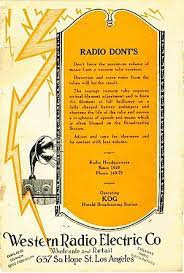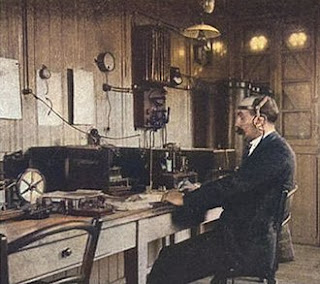 |
In 1908, three 16-year-olds made the news. Percy Palmer (who would become Long Beach High School valedictorian in 1909), established a wireless station in a little building at the rear of his parent’s home on West Second Street. Learning more about the new “science” became an obsession which he shared with neighbor George Nelson, who set up his own wireless a half block from Palmer. Douglas Wallace was another enthusiast and along with Percy soon had their stations fitted out with batteries, receivers, induction coils, and lofty slender poles with connecting wires. Percy proudly showed Daily Telegraph reporters (8/5/1908) the over two hundred messages which his station intercepted while Navy ships visited Long Beach, most of which were messages sent by operators on the different vessels to the officers of the fleet.
 |
| Ship to shore radio, 1904. Wikipedia |
What of Wallace? He later helped the Radio Research Society set up receiving set amplifiers for musical programs heard over station KSS and opened his own radio repair shop.
Don C. Wallace (no relation to Douglas Wallace) was also a pioneer in radio. In 1912, at the age of twelve, he set up shop in a shed back of his home at 1431 Linden. He made a crystal receiving set, a transmitter, and learned the wireless code. He then built a 40-foot wireless pole. In 1913, he put in a radio phone station and sang songs which were heard seven miles away. At the age of 15 he began spending his summer vacations going to sea as a commercial radio operator on ships traveling up and down the coast. When World War I broke out, he joined the navy, becoming chief radio operator on the S.S. George Washington, President Wilson’s ship, which carried Wilson to the Versailles peace conference.
_at_Brest,_France_(30091927581).jpg) |
| President Wilson leaving the S.S. George Washington. Wikipedia |
Radio broadcasting was still very new, but Wallace coaxed President Wilson to make his Fourth of July speech into a microphone, the first presidential speech ever to go on the air. With the war over, Wallace attended the University of Minnesota, returning to Long Beach in 1927 to become sales manager of Day-Fan Electric Company's radio operations and later merchandising manager of General Motors radios in Southern California. In his spare time he built amateur radio station W6AM.
Others in Long Beach shared a love for radio and in 1912 formed the Radio Research Club, which met every Friday evening until the outbreak of WWI. In 1920 the amateur radio group, now called the Long Beach Radio Research Association, was revived by local businessmen who furnished space for the group at 244 East Third Street. Here radio publications were available for members, as well as wave meters for calibrating members’ sending sets, and buzzer practice outfits for studying code. Learning how to understand and operate what today would be called amateur or “ham” radio” was popular. Students at Poly formed the Poly High Radio Club, which discussed the use of honeycomb coils, wavelengths, vacuum tubes, Tungas rectifiers and more.
 |
| Long Beach Press 12/9/1922 |
In 1918, following the war, 35-year-old Ralph S. Prest and 22-year-old Dean Bottorff opened a small electrical shop at 18 Elm. Perhaps life as a married man (he wed May White in 1919) led Bottorff to seek a new career. He later became a vocational education teacher. In October 1920, 22-year-old Fred S. Dean replaced Bottorff in Prest’s establishment. The following year the two organized the Prest and Dean Radio Research Laboratory. The 25-member group received its government license on April 10, 1922, filing articles of incorporation in July 1922. The call letters assigned to the station were KSS. Their clubroom and workshop were at the rear of neighbor Louis Rueb’s School for Physical Correction at 26 Elm Avenue. The group had raised $2000 ($27,800 in 2021) to purchase a transmitting set with a radius of 1000 miles. The purpose of their organization, they stated, was to “make scientific investigation of the technical details of radio” supported by dues and initiation fees. Though they indicated the organization was to be non-profit, the two did profit to the point that in December 1922 Prest and Dean moved their retail establishment to larger quarters at 742 E. Fourth Street.
Permission to set up an antenna and establish a station came from the Department of Commerce, which also set limits as to what KSS could broadcast. News and stories had to be suitable for all ages and certain information such as movement of troops during war was taboo. One of the first broadcasts was on May 15, 1922, when Long Beach Fire Chief G. C. Craw spoke about fires and fire prevention. In the broadcast, Craw reported from January 1, 1922, to May 1, 1922, there were 9 fires in Long Beach, with a reported loss of $8366.76 ($138,675 in 2021). Heard throughout Southern California, the Chief asked all who listened to the broadcast to please contact him, so he would know he hadn’t just spoken into thin air.
In July the station had its first musical presentation, sponsored by Buffums’ Department Store, when Laura Barrett Holley, a well-known dramatic soprano, sang. There was also a flute solo by B. H. Ireland, and bassoon and saxophone pieces by F. C. Greissinger, both members of the municipal band.
At first there was a one-hour daily program at 7 p.m., later a matinee program was added. Programs included news, music, lectures, occasional sermons, and bedtime stories for children. The 50-watt transmitter installed at the society’s offices carried programs 600 miles in daylight and up to 1,500 miles during the evening. All of the equipment was designed and built by local enthusiasts who met every Wednesday at the station to discuss how to make their broadcast service better. The KSS license was held until June 1924, Prest and Dean finding running a radio store a more lucrative venture than hosting a radio station. They were right, radio was a booming new industry. By August 1929 there were 480,000 radios in Southern California, 1800 radio dealers, and 53 radios in every 100 homes in the region.
 |
| Press Telegram 4/2/1941 |
Prest and Dean survived the Depression until 1932, when Ralph Prest left the business, securing a job with the state highway department. Fred continued, changing the name of the establishment to Fred S. Dean Co. and in 1950 to Dean’s Electronics, when his son Norbert entered the business.
 |
| Hal Nichols. Source: Long Beach Public Library |
On March 5, 1924, a new Long Beach radio station – KFON – began broadcasting from the Markwell building (which later became part of the Jergins Trust Building) on a 234 wavelength, with Mayor Charles A. Buffum inaugurating the station. A musical program followed. Lawrence McDowell, who later worked for the Long Beach Marine Department, came to Long Beach in 1923 to work for the station, installing the station’s operating equipment. The station, owned by Hal Nichols, changed its call letters to KFOX in 1928. For more check out McDowell’s oral history narrative at Long Beach State and the Long Beach Radio History Blog at 6ccm.org
No comments:
Post a Comment